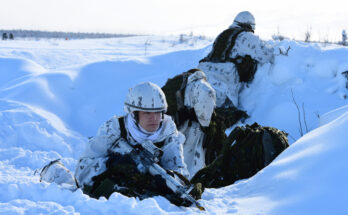
RUAG MRO International completed MRO services on two Bangladesh Navy (BN) Dornier 228-212 special mission aircraft. Image – RUAG
RUAG is capping off a dramatic change that has split the company into two independent firms, one focused on supporting the Swiss military and the other on commercial aerospace.
On January 1, 2020, RUAG Holding AG became a new holding company with two subsidiaries: MRO Switzerland (roughly 2,500 employees with manufacturing sites in Switzerland), which will be responsible for providing services to the Swiss armed forces, and RUAG International (approximately 6,500 employees, with about two-thirds international), which will control the business sectors in civil aerostructures and space.
The split will help the new RUAG International grow on the international market, as it has been hampered in the past by Swiss law. More specifically, arms sales outside of Switzerland have been hampered by Swiss prohibitions on selling arms to parties in conflict, and the combined company made sales to regions such as the Middle East cumbersome.
The new RUAG International will initially consist of four units focused on space (RUAG Space), aerostructures (RUAG Aerostructures), and the ammunition manufacturing operations for the Hunting & Sports and Armed Forces & Law Enforcement segments and for industry (RUAG Ammotec). Added to these are the civil and international activities of the former Aviation division and the Defence division’s Simulation & Training unit, which have been consolidated into a new MRO International division.
In preparation for the split, RUAG has been divesting operations it no longer considers core to either operation. According to the plan, RUAG International will continue to manage the business sections that are incompatible with the new orientation of an aerospace group, and that cannot be integrated in MRO Switzerland due to their networking with other countries. Partners will be sought that offer better prospects for these sections, which include Cyber, MRO International, and RUAG Ammotec. A joint venture is planned for Simulation & Training.
Ultimately, the goal is to privatize RUAG International once its internal restructurings are complete. As it looks to the future, RUAG is banking on the development of a new next-generation narrowbody aircraft. Here the company hopes to capitalize on the expertise it has gained in manufacturing composite structures for space vehicles. In addition, RUAG has opened new facilities in lower-cost regions such as Hungary and the United States (as compared to Switzerland) to handle labor-intensive activities. With these strategies in place, the company hopes to capture a greater share of work on any future aircraft developed by Airbus, and perhaps even Boeing.
Meanwhile, MRO Switzerland will provide all of the old RUAG’s defense-related services for the Swiss Department of Defense, Civil Protection and Sport (DDPS), which mainly focuses on maintenance, repair and overhaul of military aircraft. The MRO of aging military aircraft is a key part of this company’s strategy, which focuses on platforms such as the Northrop F-5 Tiger, which is still in service with the Swiss Air Force as well as several other air forces throughout the world. In addition, the company is working on two key programs for the Swiss military, WE89 and Upgrade 25. The WE89 program involves the modernization of the Swiss Air Force’s TH89 Super Puma transport helicopters. The Upgrade 25 program focuses on the F/A-18. Most importantly, the creation of MRO Switzerland aims to provide the Swiss government with more transparent and cost-effective services.
A military history enthusiast, Richard began at Forecast International as editor of the World Weapons Weekly newsletter. As the Internet grew in importance as a research tool, he helped design the company's Forecast Intelligence Center and currently coordinates the EMarket Alert newsletters for clients. Richard also manages social media efforts, including two new blogs: Defense & Security Monitor, covering defense systems and international issues, and Flight Plan, which focuses on commercial aviation and space systems. For over 30 years, Richard has authored the Defense & Aerospace Companies, Volume I (North America) and Volume II (International) services. The two books provide detailed data on major aerospace and defense contractors. He also edits the International Contractors service, a database that tracks all the contractors involved in the programs covered in the FI library. More recently he was appointed Manager, Information Services Group (ISG), a new unit that encompasses developing outbound content for both Forecast International and Military Periscope.




